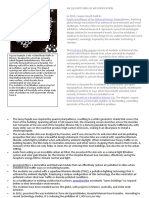0% found this document useful (0 votes)
3 views1 pageMethods
The document outlines safety precautions necessary for working on a prototype, including wearing protective gear. It details the construction steps of the project, which involves creating a clay ceramic container, applying photocatalytic materials, and making a filter from coconut fibers to purify air from pollutants. Additionally, it mentions the use of pollutant sensors to measure VOCs and PM10 levels.
Uploaded by
osssu65Copyright
© © All Rights Reserved
We take content rights seriously. If you suspect this is your content, claim it here.
Available Formats
Download as PDF, TXT or read online on Scribd
0% found this document useful (0 votes)
3 views1 pageMethods
The document outlines safety precautions necessary for working on a prototype, including wearing protective gear. It details the construction steps of the project, which involves creating a clay ceramic container, applying photocatalytic materials, and making a filter from coconut fibers to purify air from pollutants. Additionally, it mentions the use of pollutant sensors to measure VOCs and PM10 levels.
Uploaded by
osssu65Copyright
© © All Rights Reserved
We take content rights seriously. If you suspect this is your content, claim it here.
Available Formats
Download as PDF, TXT or read online on Scribd
/ 1




























































